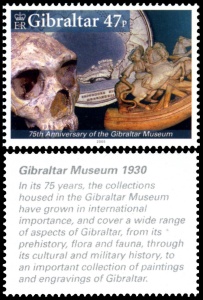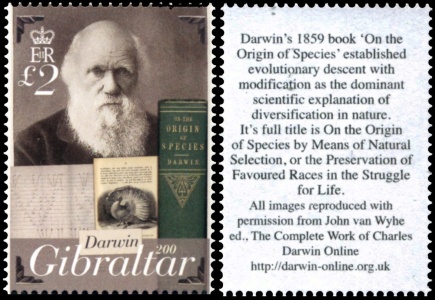the place where Paleontology and Paleoanthropology meets Philately
Gibraltar
Prehistoric animals, Neanderthal, the Rock, fossil found place,
Charles Darwin on stamps and postmarks of Gibraltar
| << previous country | back to index | next country >> |
Contents:
- Country overview
- Philately of Gibraltar
- Official stamps of Gibraltar related to Paleontology
- Other official stamps of Gibraltar to consider
- Some personalized stamps of Gibraltar related to Paleontology
- Some that appear to be related to Paleontology, but are not
- Some postmarks to consider
- References
- Acknowledgements
Gibraltar is a British Overseas Territory located on the southern end of the Iberian Peninsula. It has an area of 6.7 km2 and shares its northern border with Spain. The Rock of Gibraltar is the major landmark of the region. At its foot is a densely populated city, home to over 30,000 people.
The sovereignty of Gibraltar is a major point of contention in Anglo-Spanish relations as Spain asserts a claim to the territory. Gibraltarians overwhelmingly rejected proposals for Spanish sovereignty in a 1967 referendum and again in 2002. Under the Gibraltar constitution of 2006, Gibraltar governs its own affairs, though some powers, such as defence and foreign relations, remain the responsibility of the Government of the United Kingdom. [R1]
On the 1st January 1886 the Colonial Government of Gibraltar assumed control of its Postal Services. As an interim measure, Bermuda stamp plates were overprinted with 'Gibraltar' using different colors. These were replaced by Gibraltar's own design in December of that same year.
The first commemorative issue was in 1935. Since 1966 subjects of a predominantly local flavor have been chosen through international events are also featured. [R2]
Official stamps of Gibraltar related to Paleontology and Paleoanthropology: prehistoric animals, Neanderthal, Charles Darwin
| 22.03.1973 "125th anniversary of discovery of the Gibraltar skull (Neanderthal)" [1] | 09.05.2000 "The history of Gibraltar" [2] | 08.05.2005 "Gibraltar Anniversaries" [3] |
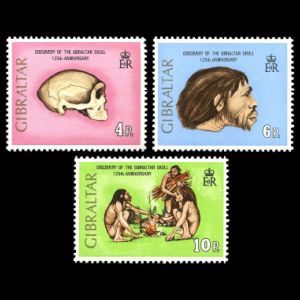 |
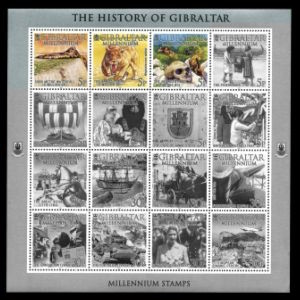 |
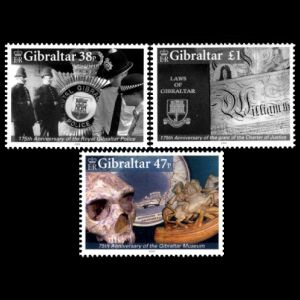 |
| 09.11.2009 "Charles Darwin" [4] | 20.09.2016 "UNESCO Gorham's Cave Complex" [5] | |
 |
 |
|
Notes:
[1] Two stamps from the "125th anniversary of discovery of the Gibraltar skull" set contain 3 stamps: skull of Neanderthal woman, a "classical" Neanderthal type and lunchtime on the Rock 50,000 years ago. There are several Neanderthal fossils found at various caves in Gibraltar, including the first skull of a Neanderthal ever found.

|
Normal stamp, without any error, on the left, MiNr.: 299, Scott: 296
The stamp with omitted country name, MiNr.: 299F, is in the middle.
The stamp with omitted golden color at the country name is in the right.
|
There are at least 5 known stamps of MiNr 299 that have an error – the name of the country was omitted. These stamps are cataloged as MiNr 299f. Copies were reportedly found in presentation packs and were later sold at auction for approximately 7000 euros.
A second error is not documented in the stamp catalogs to date (both errors are not listed in the 2017 Scott Catalog). The golden color was omitted during printing, leaving the country name black in color. This error is known from one FDC so far.
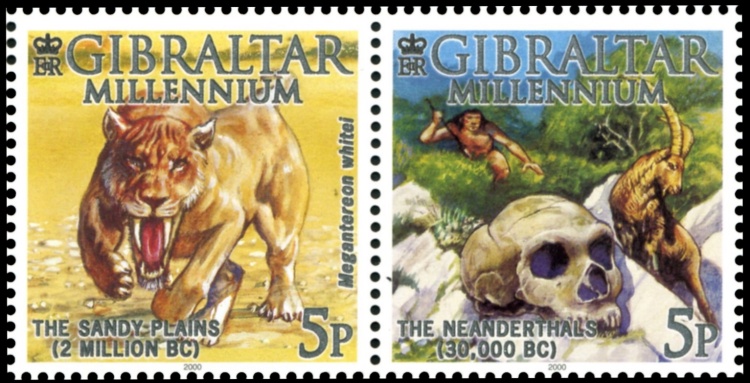
|
Sabertooth cat 'The Sandy Plains' - Megantereon whitei, MiNr.: 915, Scott: 841b.
Hunting Neanderthals, MiNr.: 916, Scott: 841c.
|
[2] Two stamps from the sheet of 16 shows some scenes from the prehistoric past of Gibraltar.
- The second stamp in the top row shows “The Sandy Plains” which depicts Megantereon whitei, who roamed Gibraltar 2 million years ago.
- The third stamp in the top row shows a scene of neanderthals hunting prey, reconstructing what Gibraltar would have looked like approximately 130,000 years ago.
In Europe the oldest remains are known from Les Etouaries (France), a site which is now dated to less than 2.5 million years old.
The youngest remains in Europe were found near Untermassfeld in Germany, and were estimated to be 900,000 years old.
Megantereon was built like a large modern jaguar, but somewhat heavier. It may have been the ancestor of Smilodon.
2 million years ago the landscape of Gibraltar was very different from today.
As a result of the ice age, sea level dropped exposed much new land around Gibraltar. This land was colonized by plants and developed a series of habitats including sandy pine woods, marshlands and plains.
There are also some indications that the sea level falls from time to time allowed a faunal exchange between Africa and Europe. [R4]
[3] One of the stamps shows some artifacts of the Gibraltar Museum.
Established in 1930, the Gibraltar Museum’s collection is of international importance and covers a wide range of Gibraltar’s natural history including exhibits on its prehistory, flora and fauna.
One such important artifacts is the skull of Neanderthal.
All three stamps have short descriptive texts on the reverse side of the stamp – as shown in the figure on the right of the stamp.
[4] The 2005 Darwin set was issued in honor of the 200th year since Charles Darwin’s birth.
Four stamps were issued as separate sheets – each stamp had descriptive text on the reverse side that explained the image on the front. A fifth stamp was issued as part of a souvenir sheet – no descriptive text was present on the back.
[5] Gorham's Cave is a natural sea cave in Gibraltar, considered to be one of the last sites inhabited by Neanderthals in Europe. Gorham's Cave gives its name to the Gorham's Cave Complex, which is a combination of four distinct caves of such importance that they are combined into a UNESCO World Heritage Site. Some Neanderthals are depicted on stamp with face value of 80p.
Other official stamps to consider: found place of Neanderthal fossils
| 15.09.2002 "Rock of Gibraltar" [A1] [A2] | 04.05.2004 "HM QE II Royal Visit to Gibraltar 1954" [A1] | 16.09.2009 "Old Views of Gibraltar" [A1] |
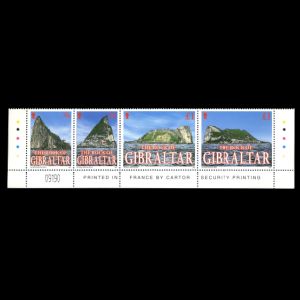 |
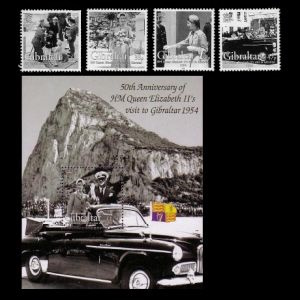 |
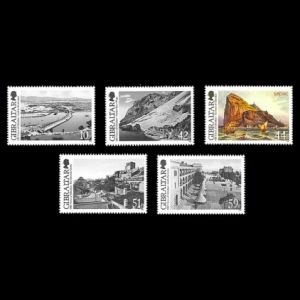 |
| 18.05.2018 "100th anniversary of Royal Air Force" [A1] | 15.05.2018 "Cryptocurrency Sheet" [A1] [A3] | 31.07.2018 "Views of the Rock" [A1] |
 |
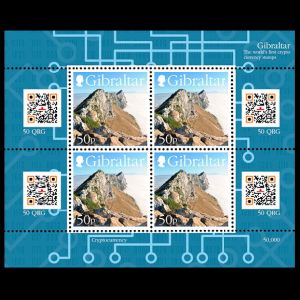 |
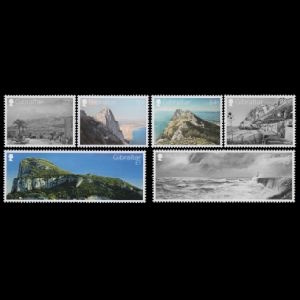 |
Notes:
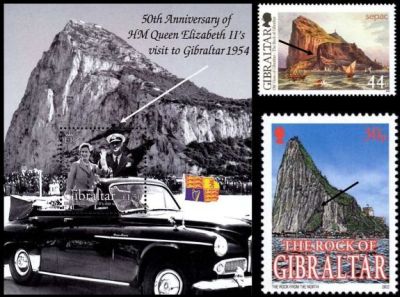 [A1] The Gibraltar Neanderthals
first came to light in 1848 during excavations in the course of the construction of a fortification called
Forbes' Barrier at the northern end of the Rock of Gibraltar.
The skull of a Neanderthal was discovered in Forbes' Quarry by Lieutenant Edmund Flint,
though its exact provenance is unknown, and was the subject of a presentation to
the Gibraltar Scientific Society by Lieutenant Flint in March 1848.
[R3]
[A1] The Gibraltar Neanderthals
first came to light in 1848 during excavations in the course of the construction of a fortification called
Forbes' Barrier at the northern end of the Rock of Gibraltar.
The skull of a Neanderthal was discovered in Forbes' Quarry by Lieutenant Edmund Flint,
though its exact provenance is unknown, and was the subject of a presentation to
the Gibraltar Scientific Society by Lieutenant Flint in March 1848.
[R3] The entrance to the cave is shown on three stamps, to date. The arrow point on the entrance to the cave on each stamp on the right side.
The northern end of the Rock of Gibraltar is shown on multiple stamps. New stamps and postmarks are issued frequently showing this most recognizable landmark of Gibraltar. The Rock also can be seen on some stamps of Spain.
Stamps of Gibraltar that shows the Rock:
- stamp with face value of 30p from Rock of Gibraltar set from 2002
- the block of "HM QE II Royal Visit to Gibraltar 1954" from 2004
- stamp with face value of 44p of "Old Views of Gibraltar" from 2009
- stamp with face value of 22p of "100th Anniversary of Royal Air Force" from 2018
- stamp with face value of 64p and 70p of "Views of the Rock" from 2018
The First Day Cancellation of "Views of the Rock" stamps from 2018 , based on a sketch made by the famous Abbé Breuil in 1922 showing the two sites where Neanderthals have been found: Devil’s Tower (1) and Forbe’s Quarry (2).
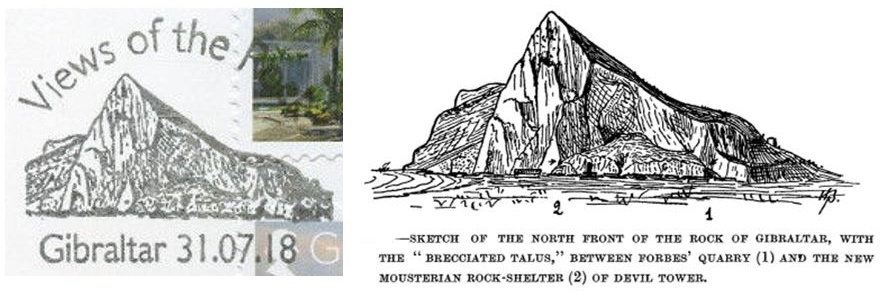
[A2] The Rock of Gibraltar stamps from 2002 are the first stamps in the world produced with actual rock incorporated in the stamps. Limestone was bored out of the center of the rock, as accessed by the Rock's World War II tunnels.
The limestone was first powdered and then sintered within the image of Gibraltar where there is rock showing. The printing process used was offset lithography together with thermography layer or limestone.
[A3] The first stamps of Gibraltar in the crypto currency, shows the famous Rock.
The 50p stamp and its four-stamp collector block below has been created by local graphics designer Mr. Stephen Perera. Any of these 4 identical QR Codes when scanned with a smartphone/tablet offers the opportunity for first time owners of these collectible blocks to collect free crypto coins which will be freely traded. In order to make this QR code and unique concept a reality a website has been created which links when scanning the QR code to permit first owners of these limited-edition blocks to redeem 200 QRG Cryptocurrency tokens/coins for each block of these stamps, one time only per unique serial number, printed on the actual sheet.
Some personalized stamps related to Paleoanthropology: fossil of Neanderthal
| 2007 "Greetings from Gibraltar" [P1] | 2018 "170 years since the discovery of Gibraltar 1 fossil" [P2] | 2023 "175th anniversary of the discovery of Gibraltar 1 fossil" |
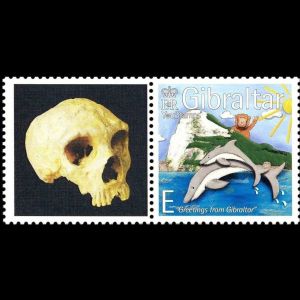 |
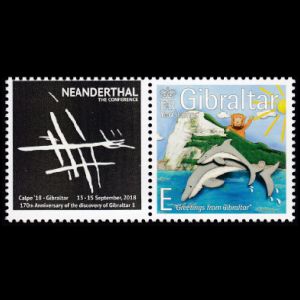 |
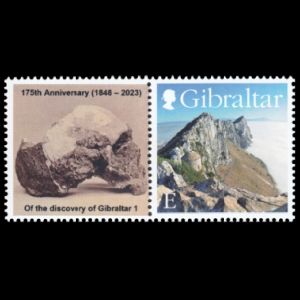 |
Notes:
[P1] On 26.09.2007 Gibraltar's Post introduced a set of YouStamps®, the set of 5 stamps of the following themes: 'Let's celebrate'; 'With love'; Greetings from Gibraltar'; 'Commitment' and 'New baby' allows everybody to print their own image on the margin.
 Face value of these stamps are G
and E:
Face value of these stamps are G
and E:G value stamp = Gibraltar to Gibraltar mail
E value stamp = Gibraltar to UK/Europe mail
( G rate is currently 10p and E rate is 44p.).
The "Greeting from Gibraltar" stamps shows the famous Rock from east side and west side on the margin. The Rock is known among Paleoanthropologists because of some Neanderthal fossils found there.
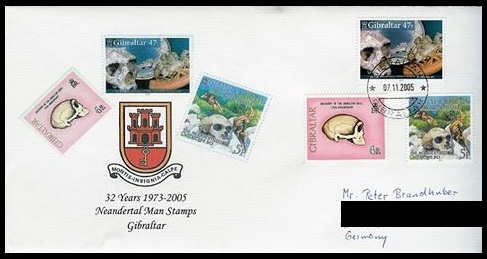 Peter Brandhuber, famous German stamp collector who
collects philatelic materials of Anthropology and Human Evolution topic (also run the "
Evolution of mankind and Philately"
group on facebook), used the opportunity to produce the personalized stamp (see above) with Neanderthal
skull found in caves in the Rock of Gibraltar.
Peter Brandhuber, famous German stamp collector who
collects philatelic materials of Anthropology and Human Evolution topic (also run the "
Evolution of mankind and Philately"
group on facebook), used the opportunity to produce the personalized stamp (see above) with Neanderthal
skull found in caves in the Rock of Gibraltar.Another example of his personalized philatelic products is an FDC with all Neanderthal stamps of Gibraltar to date (on the right side of the cover) to commemorate “32 years of Neanderthal stamps of Gibraltar”.
Mr. Brandhuber has written some articles for several German philatelic clubs. German readers can enjoy his article about Neanderthal Man stamps of Gibraltar here
[P2] Personalized stamp issued to commemorate the “Neanderthal: The Conference”. Unfortunately, no official stamps or other philatelic materials were issued on to commemorate this event. 2018 marks the 170th anniversary of the discovery of the first Neanderthal skull, dubbed Gibraltar 1. Gibraltar 1 was unearthed at Forbe’s Quarry in 1848. The Gibraltar Museum celebrated the occasion with a special Calpe Conference entitled “Neanderthal: The Conference”.
Some stamps that appear to be related to paleontology, but are not
| 26.09.2007 "Prehistoric Wildlife of Gibraltar" [O1] | ||
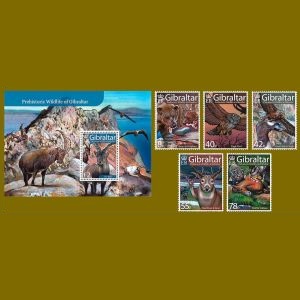 |
|
|
Notes:
[O1] This set has a misleading name, as all animal species depicted have living members in other parts of Europe or only recently became extinct.
- 8p Bears and dolphins - both are modern species
- 40p Eagle owl- modern species, that resides in much of Eurasia.
- 42p Great Auk & Eagle - the Great Auk (Pinguinus impennis)
was a flightless bird of the alcid family that became extinct in the mid-19th century.
Eagle is a modern specie. - 55p Red Deer and Boar - both are modern species still living in Europe.
The red deer (Cervus elaphus) is one of the largest modern deer species.
The wild boar (Sus scrofa) is also known as the wild swine or Eurasian wild pig. - 78p Wolf and Vulture - both are modern species.
Vulture is the name given to two groups of scavenging birds of prey. - £2 The Ibex - modern species, kind of wild goat.
Some postmarks to consider: places where Neanderthal fossils have been found
| 22.03.1973 "125th anniversary of discovery of the Gibraltar skull" [1] [FDC] | 12.11.2009 "Darwin 200th Anniversary" [FDC] | 31.07.2018 "Views of the Rock" [A1] [FDC] |
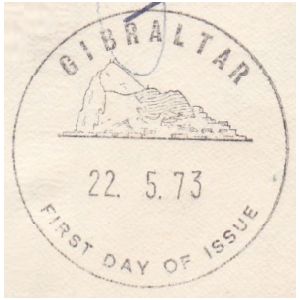 |
 |
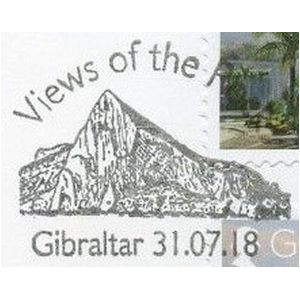 |
References:
- [R1] Gibraltar: Wikipedia WikiTravel FlagCounter
- [R2] Postal History and Philately of Gibraltar:
Wikipedia
Links to official website of the Post Authority, stamp catalog and a list of new stamps of Gibraltar are here - [R3] Neanderthals of Gibraltar: Wikipedia
- [R4] Megantereon: Wikipedia
- [R5] CALPE Conference 2018: Gibraltar national Museum.
Acknowledgements:
- many thanks to Peter Brandhuber for his help and sharing scans of some unique philatelic material from his personal collection.
- many thanks to Dr. Peter Voice from Department of Geological and Environmental Sciences, Western Michigan University, for the draft page review and his valuable comments.
| << previous country | back to index | next country >> |
